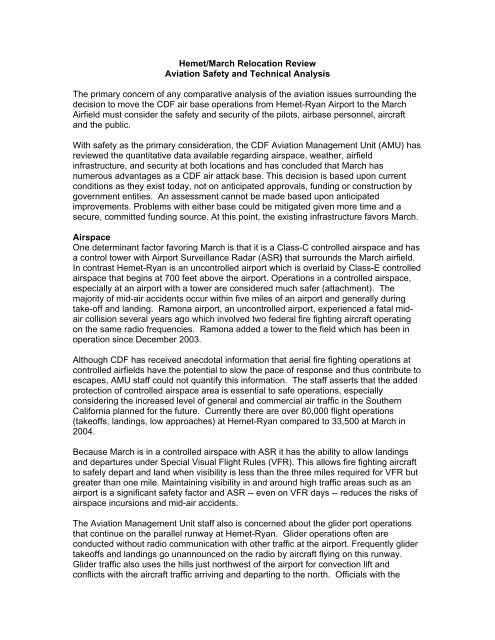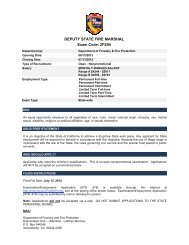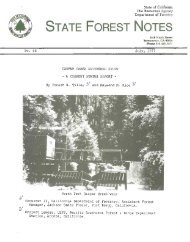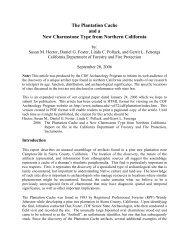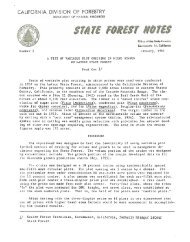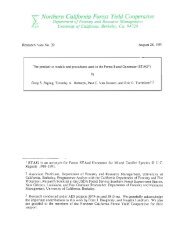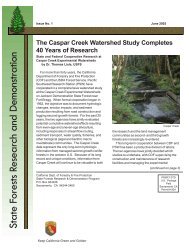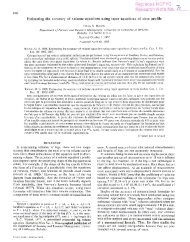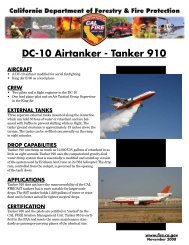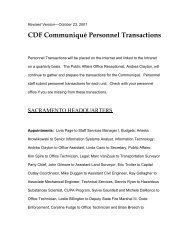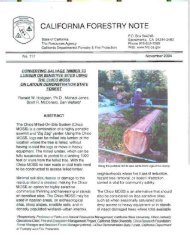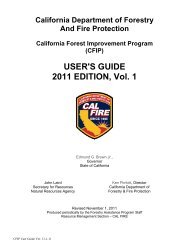You also want an ePaper? Increase the reach of your titles
YUMPU automatically turns print PDFs into web optimized ePapers that Google loves.
Hemet/March Relocation Review<br />
Aviation Safety and Technical Analysis<br />
The primary concern <strong>of</strong> any comparative analysis <strong>of</strong> the aviation issues surrounding the<br />
decision to move the CDF air base operations from Hemet-Ryan Airport to the March<br />
Airfield must consider the safety and security <strong>of</strong> the pilots, airbase personnel, aircraft<br />
and the public.<br />
With safety as the primary consideration, the CDF Aviation Management <strong>Unit</strong> (AMU) has<br />
reviewed the quantitative data available regarding airspace, weather, airfield<br />
infrastructure, and security at both locations and has concluded that March has<br />
numerous advantages as a CDF air attack base. This decision is based upon current<br />
conditions as they exist today, not on anticipated approvals, funding or construction by<br />
government entities. An assessment cannot be made based upon anticipated<br />
improvements. Problems with either base could be mitigated given more time and a<br />
secure, committed funding source. At this point, the existing infrastructure favors March.<br />
Airspace<br />
One determinant factor favoring March is that it is a Class-C controlled airspace and has<br />
a control tower with Airport Surveillance Radar (ASR) that surrounds the March airfield.<br />
In contrast Hemet-Ryan is an uncontrolled airport which is overlaid by Class-E controlled<br />
airspace that begins at 700 feet above the airport. Operations in a controlled airspace,<br />
especially at an airport with a tower are considered much safer (attachment). The<br />
majority <strong>of</strong> mid-air accidents occur within five miles <strong>of</strong> an airport and generally during<br />
take-<strong>of</strong>f and landing. Ramona airport, an uncontrolled airport, experienced a fatal midair<br />
collision several years ago which involved two federal fire fighting aircraft operating<br />
on the same radio frequencies. Ramona added a tower to the field which has been in<br />
operation since December 2003.<br />
Although CDF has received anecdotal information that aerial fire fighting operations at<br />
controlled airfields have the potential to slow the pace <strong>of</strong> response and thus contribute to<br />
escapes, AMU staff could not quantify this information. The staff asserts that the added<br />
protection <strong>of</strong> controlled airspace area is essential to safe operations, especially<br />
considering the increased level <strong>of</strong> general and commercial air traffic in the Southern<br />
<strong>California</strong> planned for the future. Currently there are over 80,000 flight operations<br />
(take<strong>of</strong>fs, landings, low approaches) at Hemet-Ryan compared to 33,500 at March in<br />
2004.<br />
Because March is in a controlled airspace with ASR it has the ability to allow landings<br />
and departures under Special Visual Flight Rules (VFR). This allows fire fighting aircraft<br />
to safely depart and land when visibility is less than the three miles required for VFR but<br />
greater than one mile. Maintaining visibility in and around high traffic areas such as an<br />
airport is a significant safety factor and ASR -- even on VFR days -- reduces the risks <strong>of</strong><br />
airspace incursions and mid-air accidents.<br />
The Aviation Management <strong>Unit</strong> staff also is concerned about the glider port operations<br />
that continue on the parallel runway at Hemet-Ryan. Glider operations <strong>of</strong>ten are<br />
conducted without radio communication with other traffic at the airport. Frequently glider<br />
take<strong>of</strong>fs and landings go unannounced on the radio by aircraft flying on this runway.<br />
Glider traffic also uses the hills just northwest <strong>of</strong> the airport for convection lift and<br />
conflicts with the aircraft traffic arriving and departing to the north. Officials with the


